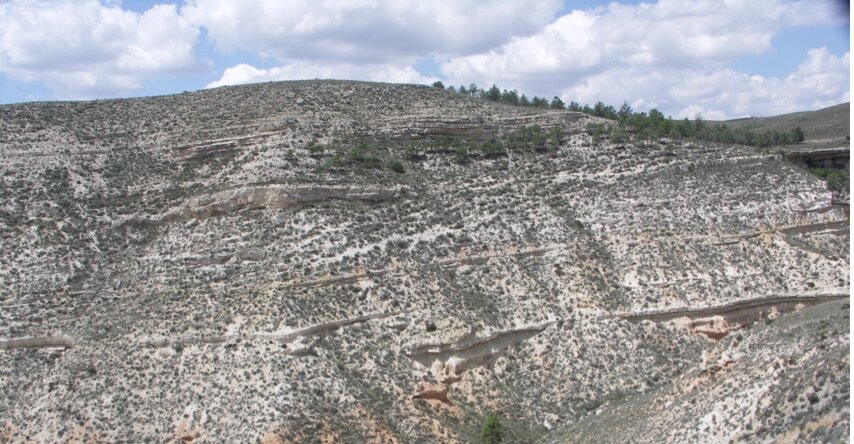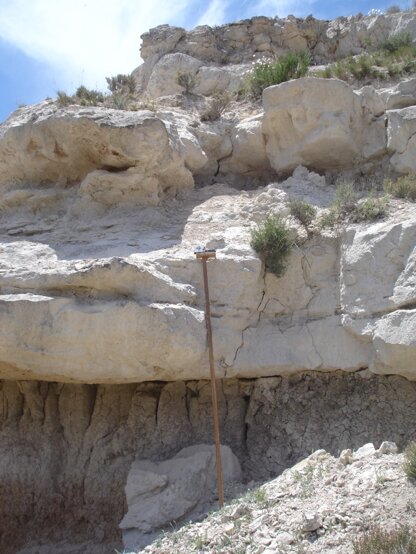(Zaragoza, Wednesday, April 6, 2022). The journal Global and Planetary Change has recently published an article showing that the connection between the dynamics in the Atlantic and the climate in the western Mediterranean area has existed since at least the Miocene (9.8 million years ago). These conclusions are derived from the analysis carried out on a sedimentary series of more than 200 m. of thickness of lacustrine carbonates of the Teruel Basin, which has made it possible to establish climatic changes between 9.8 and 1.8 million years ago at different scales.
The study, carried out by researchers from the Geotransfer group, from the University of Zaragoza, belonging to the Aragon Environmental Sciences Research Institute (IUCA), represents an important contribution to the knowledge of the climatic changes that occurred during 8 million years in the interior of the Iberian Peninsula. It shows a connection between aridity and temperature in some areas of the western Mediterranean since the Miocene and demonstrates the influence of changes in insolation on the climate, with drier and wetter conditions related to the minimum and maximum eccentricity of the Earth’s orbit, respectively. In the same way, it shows the influence that changes in the North Atlantic ocean current circulation (AMOC)[1] have exerted since the Miocene on the climate of southwestern Europe, through changes in the transport of heat and humidity towards the continent, as well as a relationship between mean surface ocean temperatures and variations in precipitation-evaporation in continental areas.

The results of this research work, based on the analysis of oxygen isotopes in lacustrine carbonates of the Teruel Basin, show three major climatic periods, but significant variability within them. The authors propose that the closure of the connection between the Pacific Ocean and the Central Atlantic due to the formation of the Isthmus of Panama reinforced from ~8.6 Ma ago the heat/aridity synchrony during stages of AMOC intensification through the development of a more stable center of high pressure in the Atlantic that would deflect the westerlies, or westerly winds from the Atlantic[2] to the north, increasing aridity in southwestern Europe. The most extreme aridity conditions would be reached in periods of enhanced AMOC and minimum eccentricity of the Earth’s orbit.
After the Miocene Climatic Optimum (17-14.5 Ma), a period in which the Earth was subjected to significantly higher temperatures than today, the global climate experienced a decrease in temperature of 5-6°C. Major geographic and geological changes during the late Neogene (23 to 2.6 Ma years) modified the climatic system until the current configuration was reached. Some of these changes are: the elevation of mountain ranges (Himalayas, Carpathians, Alps or Pyrenees, among others), a new configuration of oceanic circulation with modifications in the connection of some seas and oceans, the appearance of the Sahara desert, or the establishment of permanent ice in the northern hemisphere. Superimposed on the progressive long-term cooling, changes also occurred on a smaller scale, whose local effects are less well known, especially in continental areas where the records show less continuity.

Therefore, the contributions of this study, a continental record that provides information on climate change at different scales, are highly relevant for understanding future climate variations, since the global circulation models of the Earth’s climate agree that, unlike Compared to other regions of the world, in Mediterranean areas there will be a decrease in rainfall with rising temperatures. Given that the western Mediterranean reached its current geographical configuration during the Miocene, deciphering the climate changes that have occurred since then in this area, establishing the internal variability or what the mechanisms that controlled it are, are essential to understand future scenarios.
1 Atlantic Meridional Overturning Circulation (AMOC): It is a system of ocean currents, driven by changes in water salinity and temperature, that transports heat from the tropics north into the Atlantic Ocean. Once there, the water cools and returns to the south through deeper areas due to its greater density. Climate models indicate that changes in the AMOC drive changes in climate
2 They are winds that move from west to east and develop in mid-latitudes, between 30 and 60º latitude and transport heat and humidity towards the continental zones, moderating the climate. You can also put winds from the west coming from the Atlantic.
Article: Ezquerro, L.; Muñoz, A.; Liesa, C.; Simón, J.L.; Luzón, A. (2022). Late Neogene to Early Quaternary climate evolution in southwestern Europe from a continental perspective. Global and Planetary Change, 211, 103788. https://doi.org/10.1016/j.gloplacha.2022.103788

